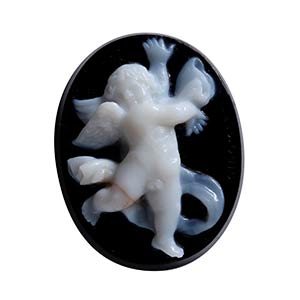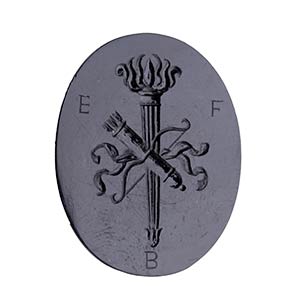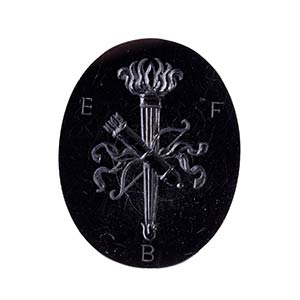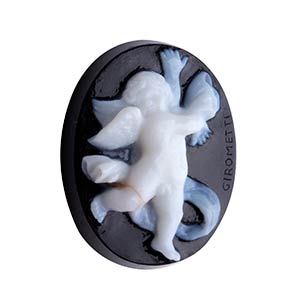
- Home
- Аукционы открытые
-
Аукционы закрытые
- Coins & Medals
- Philately
- Antiquities
- Old Masters
- Jewellery, Silver, Watches
- Ancient and Modern Glyptic
- Ancient Porcelains and Ceramics
- Antiques
- Modern & Contemporary Art
- 20th Century Design and Decorative Arts
- Prints and Multiples
- Asian and Tribal Art
- Photography
- Medieval Art
- Ancient Frames
- Fashion, Textiles & Luxury
- Books, Autographs and Memorabilia
- Wines and spirits
- Oddities, Curiosities & Wonders
- Info
- Live Auction
- Home
- Auction 54
- 325 A fine, two-layer onyx cameo by Girometti. Cupid - winged ...
Лот 325 - Auction 54
Описание
30 x 23 x 8 mm.
Используйте форму для регистрации или введите логин в правой части формы.
За дополнительной информацией обращайтесь info@bertolamifineart.com
Категории
Аукцион: Auction 54
 Политика использования файлов cookie
Политика использования файлов cookie
Этот сайт использует файлы cookie для улучшения взаимодействия с пользователем и сбора информации об использовании сайта. Существуют также файлы cookie, которые можно использовать для выбора персонализированной рекламы и рекламного контента. Вы можете ознакомиться с нашей политикой использования файлов cookie, принять все файлы cookie и продолжить просмотра, нажав "Принять" или измените свой выбор, нажав "Настроить".
Политика использования файлов cookie
Файлы cookie
Чтобы этот сайт работал должным образом, мы иногда устанавливаем на ваше устройство небольшие файлы данных, называемые " cookie ". Большинство крупных сайтов делают то же самое.
Что такое файлы cookie?
Файл cookie - это небольшой текстовый файл, который веб-сайты сохраняют на вашем компьютере или мобильном устройстве во время их посещения. Благодаря файлам cookie сайт запоминает ваши действия и предпочтения (например, логин, язык, размер шрифта и другие параметры отображения), чтобы вам не приходилось повторно вводить их, когда вы возвращаетесь на сайт или переходите с одной страницы на другую.
Как мы используем файлы cookie?
Сторонние файлы cookie
Google Analytics
Этот сайт использует Google Analytics для сбора информации об использовании пользователями его веб-сайта. Google Analytics генерирует статистическую и другую информацию с помощью файлов cookie, хранящихся на компьютерах пользователей. Информация, полученная в отношении нашего веб-сайта, используется для составления отчетов об использовании веб-сайтов. Google будет хранить и использовать эту информацию. Политика конфиденциальности Google доступна по следующему адресу: https://policies.google.com/privacy .
Для работы сайта не обязательно включать файлы cookie, но это улучшает навигацию. Можно удалить или заблокировать файлы cookie, но в этом случае некоторые функции сайта могут работать некорректно.Информация о файлах cookie не используется для идентификации пользователей, и данные навигации всегда находятся под нашим контролем. Эти файлы cookie используются исключительно для целей, описанных здесь.
Как контролировать и изменять файлы cookie?
Вы можете изменить или отозвать свое согласие в любое время в декларации файлов cookie на наш сайт.
Политика конфиденциальности
Узнайте больше о том, кто мы такие, как вы можете связаться с нами и как мы обрабатываем личные данные, в нашем политика конфиденциальности .
Необходимые файлы cookie помогают сделать веб-сайт пригодным для использования за счет включения основных функций, таких как навигация по страницам и доступ к защищенным областям сайта. Веб-сайт не может нормально функционировать без этих файлов cookie.
| Имя | Поставщик | Цель | Срок действия |
|---|---|---|---|
| cookieConsent | Bid Inside | Сохраняет статус согласия пользователя на cookie для текущего домена | 6 месяцев |
| PHPSESSID | Bid Inside | Сохранять статус пользователя на разных страницах сайта. | Когда сеанс просмотра заканчивается |
| f_display | Bid Inside | Файлы cookie f_display запоминают режим отображения, выбранный пользователем на страницах, где есть списки. | Когда сеанс просмотра заканчивается |
| f_page | Bid Inside | Файлы cookie f_page хранят страницу, просмотренную пользователем, на страницах, где есть списки. | Когда сеанс просмотра заканчивается |
| f_rec_page | Bid Inside | Файлы cookie f_rec_page хранят количество элементов, которые должны отображаться на странице, выбранной пользователем на страницах, на которых есть списки. | Когда сеанс просмотра заканчивается |
| f_order_by | Bid Inside | Файлы cookie f_order_by хранят выбранный пользователем параметр сортировки на страницах, где есть списки. | Когда сеанс просмотра заканчивается |
| f_order_dir | Bid Inside | Файлы cookie f_order_dir хранят направление упорядочивания, выбранное пользователем на страницах, где есть списки. | Когда сеанс просмотра заканчивается |
| watch_list_show_imgs | Bid Inside | Файл cookie watch_list_show_imgs хранит выбор пользователя, отображать или скрывать изображения лотов на странице списка наблюдения | Когда сеанс просмотра заканчивается |
| selected_voice | Bid Inside | В файле cookie selected_voice хранится голос, выбранный пользователем для синтеза речи, присутствующий на живом аукционе | 1 Месяц |
| include_autobids | Bid Inside | Файл cookie include_autobids сохраняет выбор пользователя — показывать или скрывать свои auto-bid на странице «Ваши ставки». | 6 месяцев |
Аналитические файлы cookie помогают понять, как посетители взаимодействуют с веб-сайтом, собирая и передавая статистическую информацию контроллеру данных.
| Имя | Поставщик | Цель | Срок действия |
|---|---|---|---|
| _ga | Зарегистрируйте уникальный идентификатор, используемый для генерации статистических данных о том, как посетитель использует веб-сайт. | 2 года | |
| _gat_gtag | Используется Google Analytics для ограничения частоты запросов | 1 день | |
| _gat | Используется Google Analytics для ограничения частоты запросов | 1 день | |
| _gid | Зарегистрируйте уникальный идентификатор, используемый для генерации статистических данных о том, как посетитель использует веб-сайт. | 1 день | |
| __utma | Bid Inside | Используется для различения пользователей и сеансов. Файл cookie создается, когда библиотека javascript выполняется, а существующие файлы cookie __utma не существуют. Файл cookie обновляется каждый раз, когда данные отправляются в Google Analytics. | 2 годы |
| __utmt | Bid Inside | Используется для ограничения скорости запросов. | 10 минут |
| __utmb | Bid Inside | Используется для определения новых сеансов / посещений. Файл cookie создается, когда библиотека javascript выполняется, а существующие файлы cookie __utmb не существуют. Файл cookie обновляется каждый раз, когда данные отправляются в Google Analytics. | 30 минут |
| __utmc | Bid Inside | Не используется в ga.js. Набор для взаимодействия с urchin.js. Исторически этот файл cookie работал вместе с файлом cookie __utmb, чтобы определить, был ли пользователь в новом сеансе / посещении. | Когда сеанс просмотра заканчивается |
| __utmz | Bid Inside | Сохраняет источник трафика или кампанию, объясняющую, как пользователь попал на ваш сайт. Файл cookie создается при запуске библиотеки javascript и обновляется каждый раз, когда данные отправляются в Google Analytics. | 6 месяцы |
| __utmv | Bid Inside | Используется для хранения данных пользовательских переменных на уровне посетителя. Этот файл cookie создается, когда разработчик использует метод _setCustomVar с настраиваемой переменной уровня посетителя. Этот файл cookie также использовался для устаревшего метода _setVar. Файл cookie обновляется каждый раз, когда данные отправляются в Google Analytics. | 2 годы |
Предпочтительные / технические файлы cookie позволяют веб-сайту запоминать информацию, которая влияет на то, как сайт ведет себя или представляет себя, например, ваш предпочтительный язык или регион, в котором вы находитесь.
Мы не используем файлы cookie этого типа.Профилирующие файлы cookie используются в маркетинговых целях для отслеживания посетителей веб-сайта. Их цель - отображать релевантную и привлекательную рекламу для отдельного пользователя.
| Имя | Поставщик | Цель | Срок действия |
|---|---|---|---|
| _fbp | 6 months | ||
Неклассифицированные файлы cookie - это файлы cookie, которые классифицируются вместе с отдельными поставщиками файлов cookie.
Мы не используем файлы cookie этого типа.








 326
326